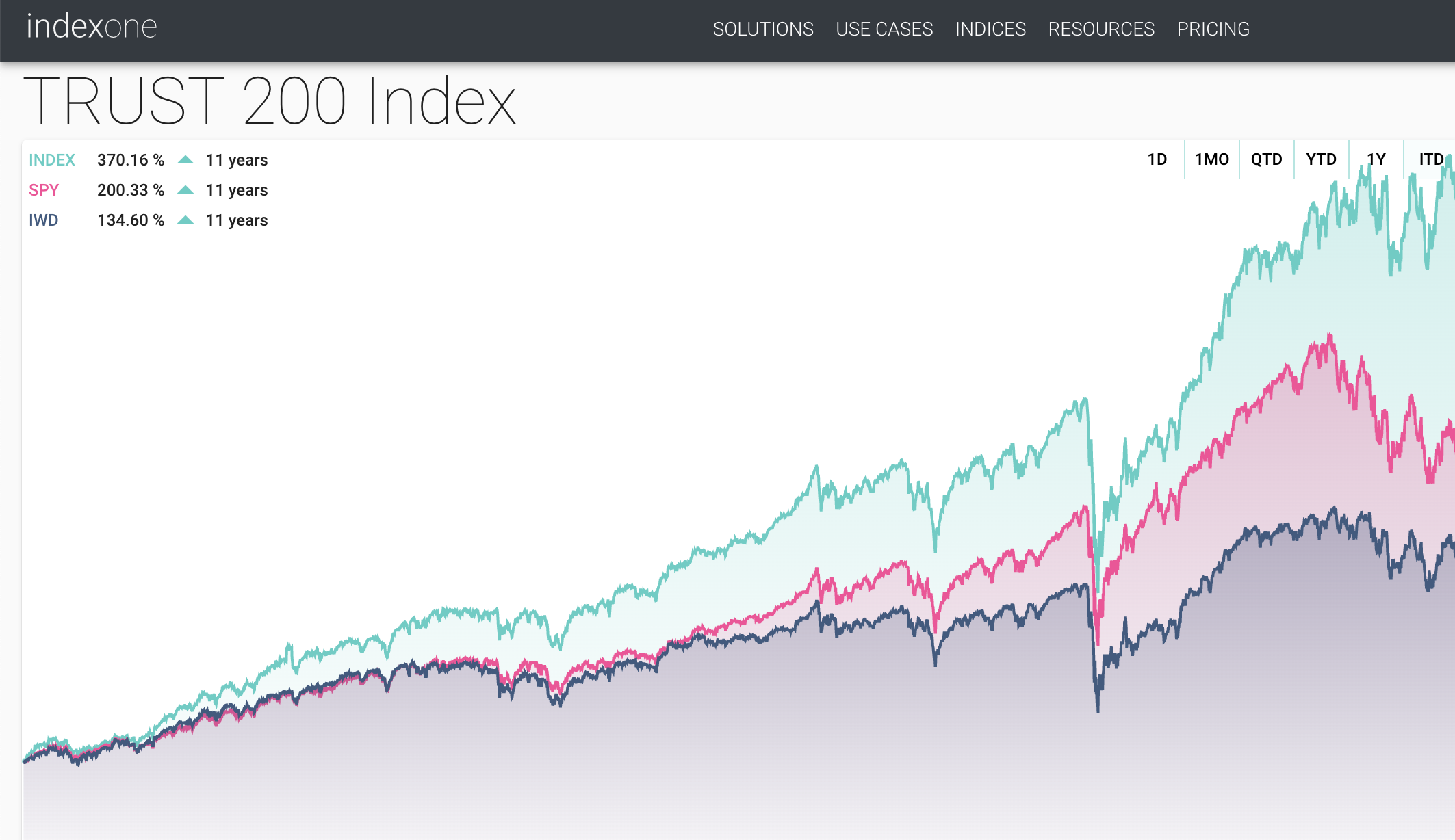
What is the average lifespan of a public company?
“A recent study by McKinsey found that those companies listed in Standard & Poor’s 500 was 61 years in 1958. Today, it is less than 18 years. McKinsey believes that in 2027, 75% of the companies currently quoted on the S&P 500 will have disappeared.” While some might question this conclusion or argue that disruptive technology is primarily to blame, maybe lack of trustworthiness is the real culprit.
Every year Trust Across America-Trust Around the World creates a “Top 10” Most Trustworthy Public Company list. The 2022 list can be found here. Four of the companies were founded in the 1800s and all but one has been in business for more than 18 years. The average life span of the ten companies is 77 years. Could it be that the most trustworthy companies are not only great innovators, but also tend to stay in business because they are well governed?
Some of warning signs of poor governance and low trustworthiness may surprise you.
- Trust is taken for granted and viewed as a soft skill. Either leadership never discusses it, or worse yet attempts to delegate it.
- There is a new chief in town who holds the title of Chief Trust Officer but it is not the CEO (see #1 above) as it should be, and the job description is similar if not identical to the Chief Risk Officer. Trust building and risk mitigation skillsets are not one and the same and trust always starts at the top.
- The skillset of the “leadership” team needs a serious reset. For example, layoffs are a first line of defense.
- Employee turnover is high but no one is asking why.
- The company website contains lots of Kumbaya “words” that do not translate into action. Just ask the employees.
- Strategies for elevating organizational trust and trustworthiness have never been discussed let alone described, shared or agreed upon.
- Leadership focuses on survival and short-term profitability. In fact in many cases, compensation is directly tied to quarterly earnings.
- Board diversity in gender and race are present but sorely lacking is diversity of thought or opinions.
- A well defined/aligned hiring strategy has not been implemented resulting in cultural confusion and non engaged employees.
- Expensive Short-term “perception of trust” programs/workarounds are abundant. (Hint: Think about whether the program can easily tick a box.)
Take a look at this infographic for some additional insights.
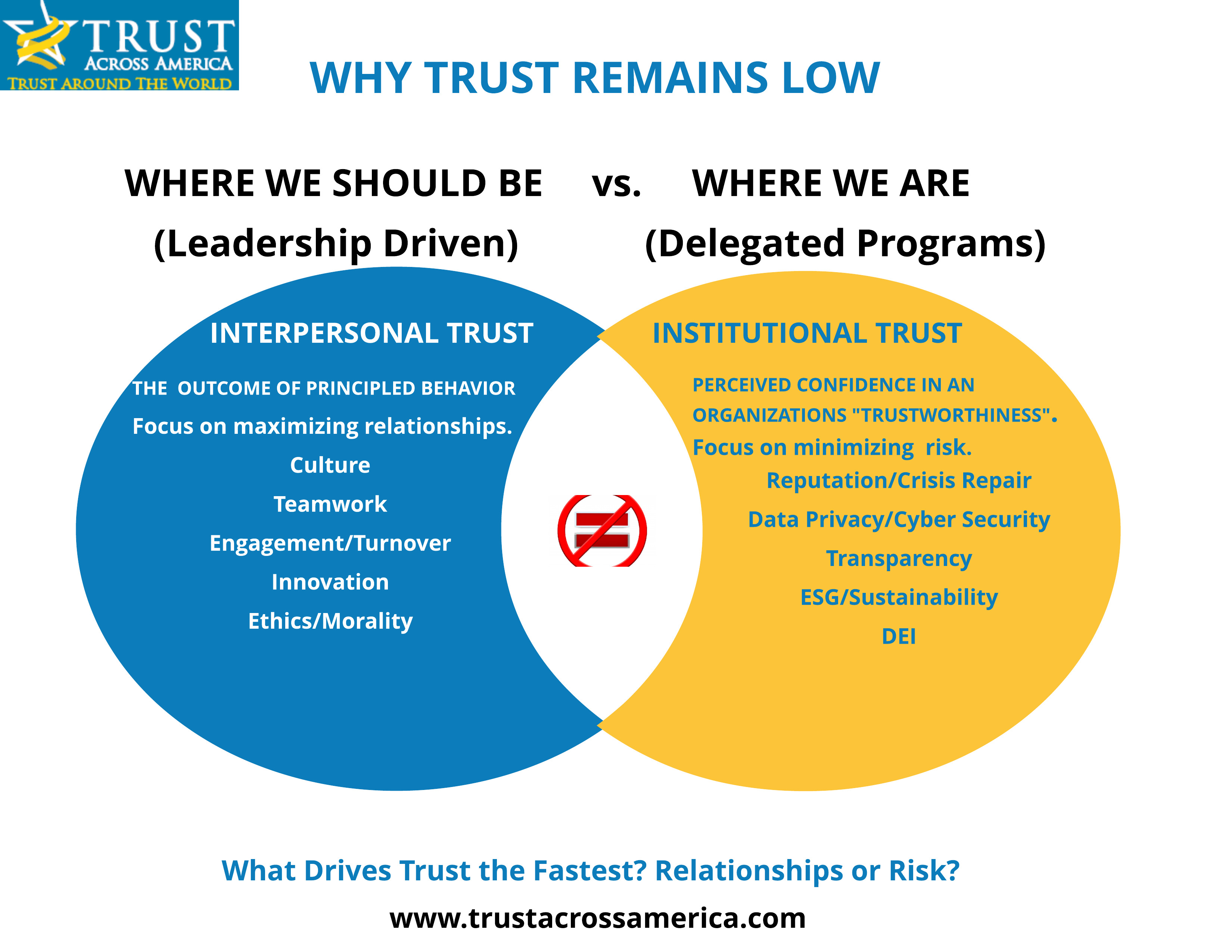
Elevating trust and trustworthiness does not require complex formulas. Most of these warning signs can be easily addressed given the right tools and resources, and a willingness to fix what is broken. Want to learn more about building organizational trust and trustworthiness? Our website provides an endless number of tools and resources.
Barbara Brooks Kimmel is an author, speaker, product developer and global subject matter expert on trust and trustworthiness. Founder of Trust Across America-Trust Around the World she is author of the award-winning Trust Inc., Strategies for Building Your Company’s Most Valuable Asset, Trust Inc., 52 Weeks of Activities and Inspirations for Building Workplace Trust and Trust Inc., a Guide for Boards & C-Suites. She majored in International Affairs (Lafayette College), and has an MBA (Baruch- City University of NY). Her expertise on trust has been cited in Harvard Business Review, Investor’s Business Daily, Thomson Reuters, BBC Radio, The Conference Board, Global Finance Magazine, Bank Director and Forbes, among others.
Join our Constant Contact mailing list for updates on our progress.
Barbara Brooks Kimmel, C-Suite, CEO, culture, leadership, organizational trust

Business leaders are constrained by the number of hours in the day, competing demands, and how they choose to prioritize their time. Sadly many spend a large percentage of their day reacting to crises and extinguishing fires. This is lost time that could be better allocated to proactively building their brand.
From our research over 15+ years we know that trustworthy organizations make for good business and are less risky, yet the majority of leaders do not embrace the long-term benefits of trust. If they did, some of their time would be freed up for more worthwhile pursuits. If you are a leader and this sounds remotely interesting to you, start by asking yourself these ten questions.
Ten Questions For Leaders Seeking to Build Trustworthy Organizations
- Have I acknowledged or ignored the business case for trust?
- Am I personally trustworthy? Does trust matter to me as an individual or in my professional life?
- Is trust mentioned in our mission/vision statement or corporate credo? If not, why not?
- Do all stakeholders view me as trustworthy? Have I asked?
- Do I speak about the importance of trust on a regular basis?
- Do I engage my employees in discussions about trust?
- Do I own and model trust building behaviors? Am I transparent, accountable, respectful?
- Do I celebrate achievements? Do I allow mistakes?
- Do I have a trust tracking mechanism in place?
- Have I budgeted for trust building programs?
What other questions should leaders be asking themselves in pursuit of building trustworthy organizations? Leave a comment.
Barbara Brooks Kimmel is an author, speaker, product developer and global subject matter expert on trust and trustworthiness. Founder of Trust Across America-Trust Around the World she is author of the award-winning Trust Inc., Strategies for Building Your Company’s Most Valuable Asset, Trust Inc., 52 Weeks of Activities and Inspirations for Building Workplace Trust and Trust Inc., a Guide for Boards & C-Suites. She majored in International Affairs (Lafayette College), and has an MBA (Baruch- City University of NY). Her expertise on trust has been cited in Harvard Business Review, Investor’s Business Daily, Thomson Reuters, BBC Radio, The Conference Board, Global Finance Magazine, Bank Director and Forbes, among others.
. 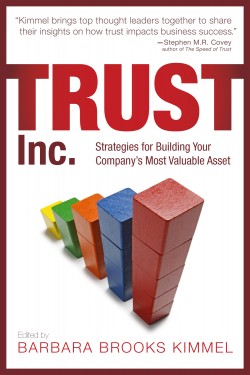
Barbara Brooks Kimmel, CEO, culture, leadership, organizational trust, trust across america

So what’s your trust excuse?
Fifteen years is a long time to be “talking trust” with leaders and managers, and yet something keeps me doing it. I have spoken with hundreds if not thousands of business leaders during this time from small startups to Fortune 500 and, given the opportunity, ask this question.
What role if any does trust play in your work?
And these are the most common responses in no particular order.
- None, trust is a soft skill
- None, there is no business case
- None, we have no budget
- None, we do not consider it a measurable risk
- I never thought about it
- My employees trust me
- Huge, every year we bring in a “big name” motivational speaker
- None, I have too many daily fires to extinguish
- None, it’s not my job
- None, are you kidding?
What’s the message here? Whether you are a leader, manager or work as a member of a team, if you do not intentionally choose trust building as part of your daily activities, do not expect it to flourish. It does not happen on its own.
If you are interested in learning more, take a look below.
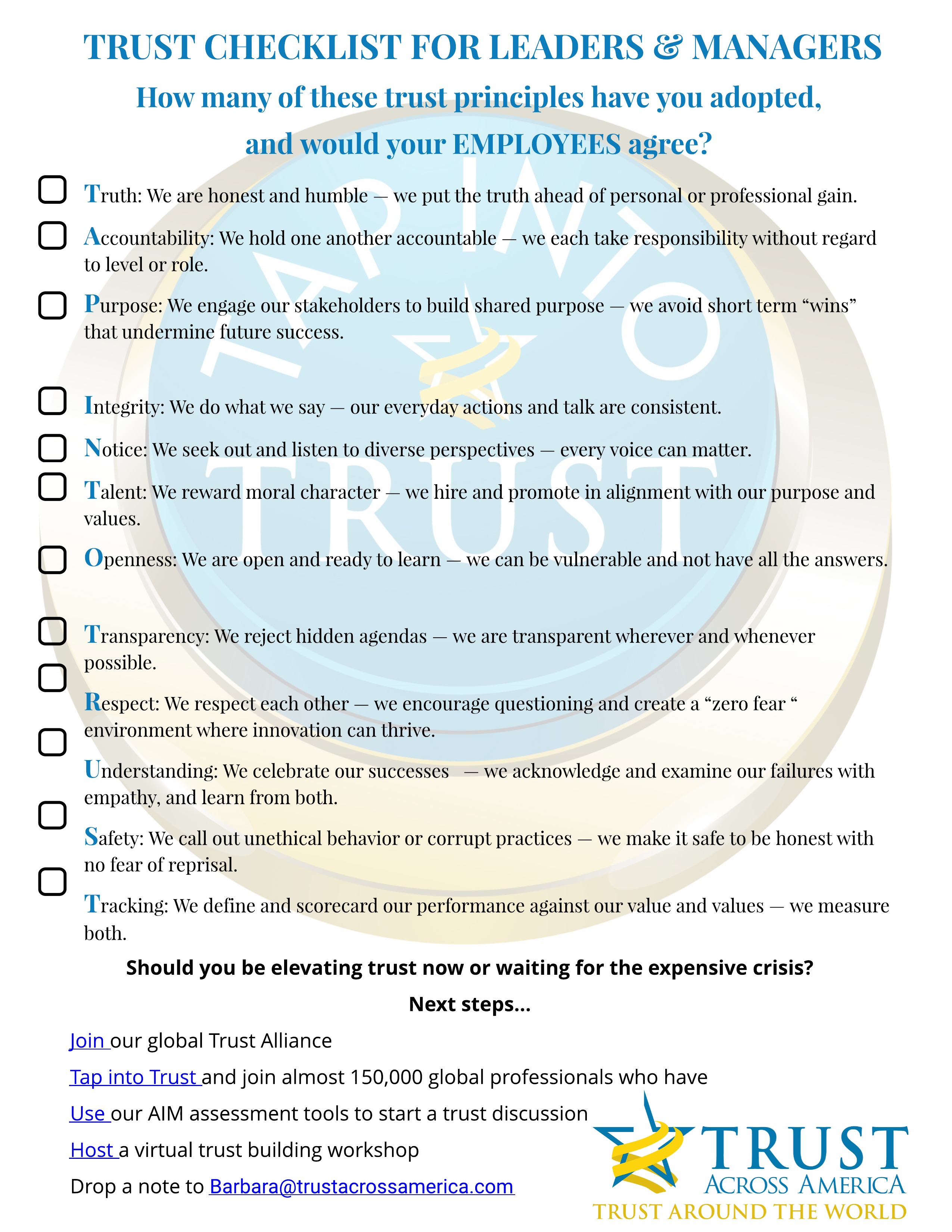
Barbara Brooks Kimmel is an author, speaker, product developer and global subject matter expert on trust and trustworthiness. Founder of Trust Across America-Trust Around the World she is author of the award-winning Trust Inc., Strategies for Building Your Company’s Most Valuable Asset, Trust Inc., 52 Weeks of Activities and Inspirations for Building Workplace Trust and Trust Inc., a Guide for Boards & C-Suites. She majored in International Affairs (Lafayette College), and has an MBA (Baruch- City University of NY). Her expertise on trust has been cited in Harvard Business Review, Investor’s Business Daily, Thomson Reuters, BBC Radio, The Conference Board, Global Finance Magazine, Bank Director and Forbes, among others.
Barbara Brooks Kimmel, culture, leadership, organizational trust
The "Art" of TrustDecember 17th, 2021
Introducing the Trust Across America-Trust Around the World
2022 Playbook for Building Systemic Trust…

THE WHY
These turbulent times have created a unique opportunity for enlightened and ethical leaders to foster an inspiring, inclusive, innovative, engaged, safe and enduring work environment. That means taking trust beyond talk to action, and placing it in the center of the business strategy.
The twelve principles comprising The “Art” of Trust™” were collaboratively created over the course of many years by a group of leading global trust scholars and practitioners who are members of our Trust Alliance. They have been tested and used with dozens of teams and organizations. In fact, these universal principles, known by the acronym Tap Into Trust or TAP, have been accessed over 150,000 times. They provide a common language for discussing the behaviors that build high stakeholder trust, beginning internally and working outwards. Trust can be a learned competence. Understanding its behavioral components takes the emphasis away from arriving at a common definition and towards a common language. Our framework also provides a less threatening, concise and action friendly trust building solution.
THE HOW
Our 2022 playbook is designed to assist both team and organizational leaders in elevating interpersonal trust and then applying those skills to other stakeholders. Each month we will showcase one of our twelve principles, provide our monthly visual cue, a description of the behavior, team discussion questions, and additional resources including case studies. While every team faces unique trust challenges at different times, these twelve behaviors represent the most common ones that build or break trust. Sharing this playbook and having a scheduled team conversation about the monthly principle will bring the group closer to high trust by year end.
That’s our promise and our gift to you for 2022. Visit our website, hit the contact button and send us a note, or email info@trustacrossamerica.com. The playbook is free and will be delivered monthly via Constant Contact.
Let’s get started!
Barbara Brooks Kimmel, Founder Trust Across America-Trust Around the World
Barbara Brooks Kimmel, C-Suite, CEO, culture, ethics, leadership, organizational trust, playbook, trust across america
 How “safe” is your workplace?
How “safe” is your workplace?
Is honesty encouraged or is “mum” the word?
To date, over 20% of 600+ survey respondents say “Safety” is lacking in their workplace. Is it lacking in yours?
We certainly hear lots of “buzz” around “speak up” cultures and psychological safety. How often does this translate into action?
Safety is not rule based. It can’t be delegated to EH&S, legal or compliance. Leadership either chooses to embed it into the core values of the organization, model and reinforced it daily, or they do not.
Safety is the eleventh of *12 behaviors in our Tap Into Trust (TAP) framework having now been accessed over 150,000 times in 16 languages.
Trust Across America-Trust Around the World recently created The “Art” of Trust visual “cues” to start a discussion about workplace behaviors that build and weaken stakeholder trust. Together these cues form a “Wall” of Trust to enhance learning and retention.
In building team and stakeholder trust, we describe “Safety” as follows:
We call out unethical behavior or corrupt practices – we make it safe to be honest with no fear of reprisal.
Our Trust Alliance members suggest the following discussion questions to elevate safety and build workplace trust.
-
-
- How do we fix an unsafe culture?
- Have we created an environment in which all members of our organization can share honest input?
The “Art” of Trust is one of many resources designed for our Trust Action Project to help leaders, teams and organizations move from trust talk to ACTION in 2021 and beyond.
Would you like to build a Wall of Trust for your team? Take the first step.
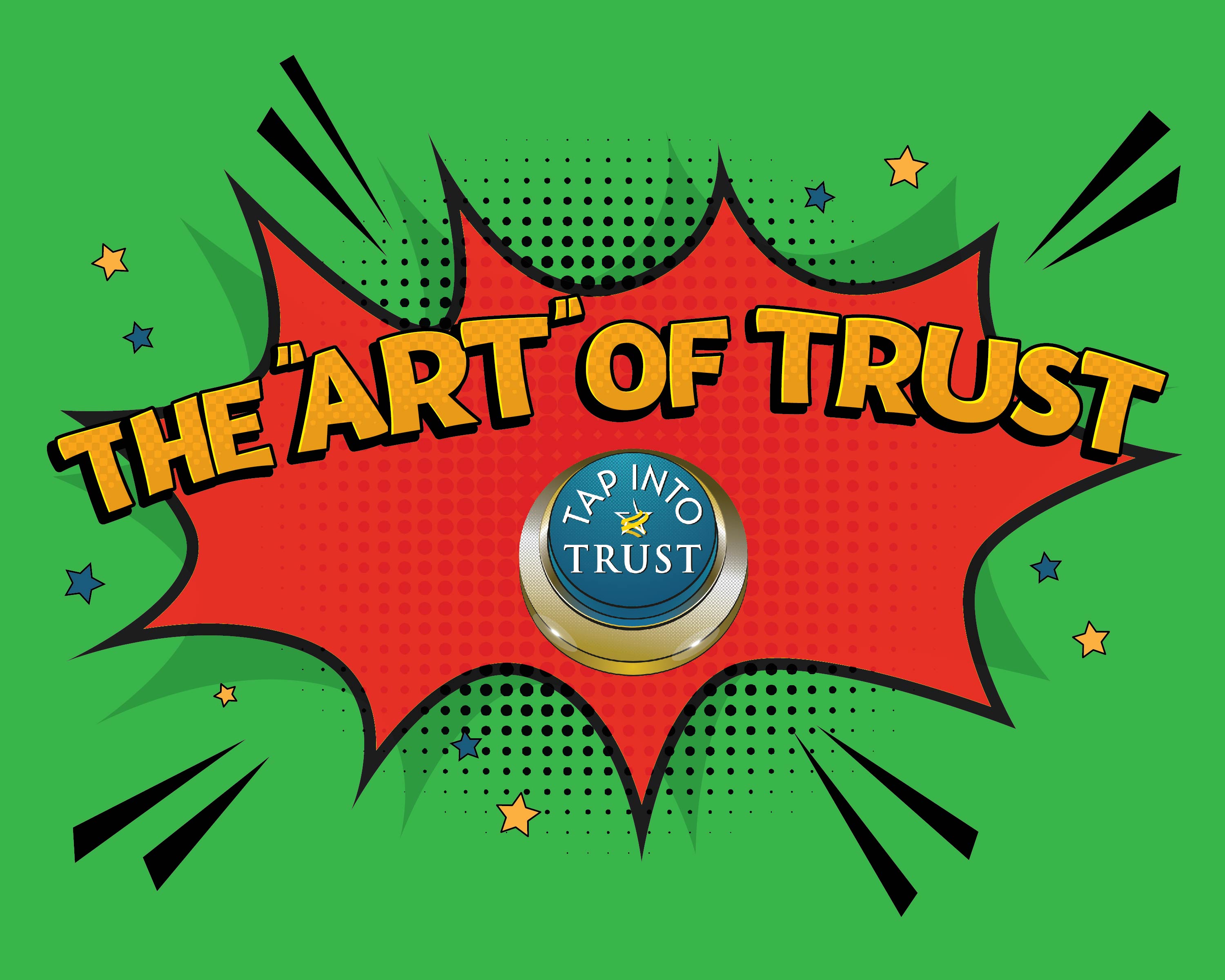
Join our global Trust Alliance and participate in our programs.
Learn more about the Trust Action Project 2021 at this link.
*TAP INTO TRUST is an acronym. The 12 behaviors are equally weighted. The weakest behaviors break the trust chain.
Copyright 2021, Next Decade, Inc.
Barbara Brooks Kimmel, culture, leadership, organizational trust, trust, values
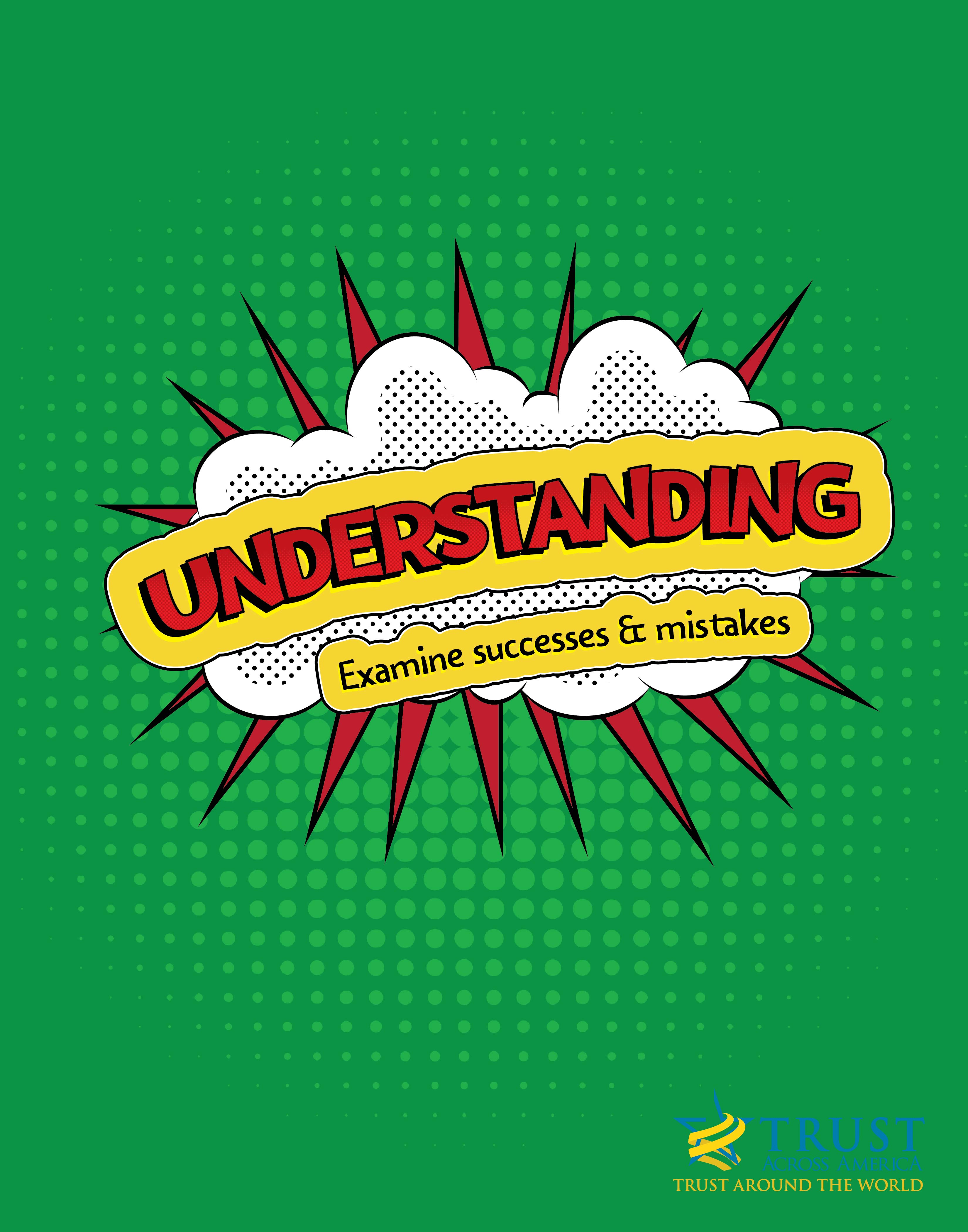 Taking time to understand and accept failure is just as important as celebrating success
Taking time to understand and accept failure is just as important as celebrating success
To date, 23% of 600+ survey respondents say “Understanding” is lacking in their workplace. Is it lacking in yours?
Understanding is the tenth of *12 behaviors in our Tap Into Trust (TAP) framework having now been accessed over 150,000 times in 16 languages.
Trust Across America-Trust Around the World recently created The “Art” of Trust visual “cues” to start a discussion about workplace behaviors that build and weaken stakeholder trust. Together these cues form a “Wall” of Trust to enhance learning and retention.
In building team and stakeholder trust, we describe “Understanding” as follows:
We celebrate our successes – we acknowledge and examine our failures with empathy, and learn from both.
Our Trust Alliance members suggest the following discussion questions to elevate respect and build workplace trust.
-
- Do employees feel safe to fail? If not, why not?
- Are we proactively asking the tough questions regarding every major undertaking so as to continuously improve and make life better for all stakeholders we impact?
The “Art” of Trust is one of many resources designed for our Trust Action Project to help leaders, teams and organizations move from trust talk to ACTION in 2021 and beyond.
Would you like to build a Wall of Trust for your team? Take the first step.

Join our global Trust Alliance and participate in our programs.
Learn more about the Trust Action Project 2021 at this link.
*TAP INTO TRUST is an acronym. The 12 behaviors are equally weighted. The weakest behaviors break the trust chain.
Copyright 2021, Next Decade, Inc.
Barbara Brooks Kimmel, culture, leadership, organizational trust, Trust Inc. Strategies for Building Your Company's Most Valuable Asset
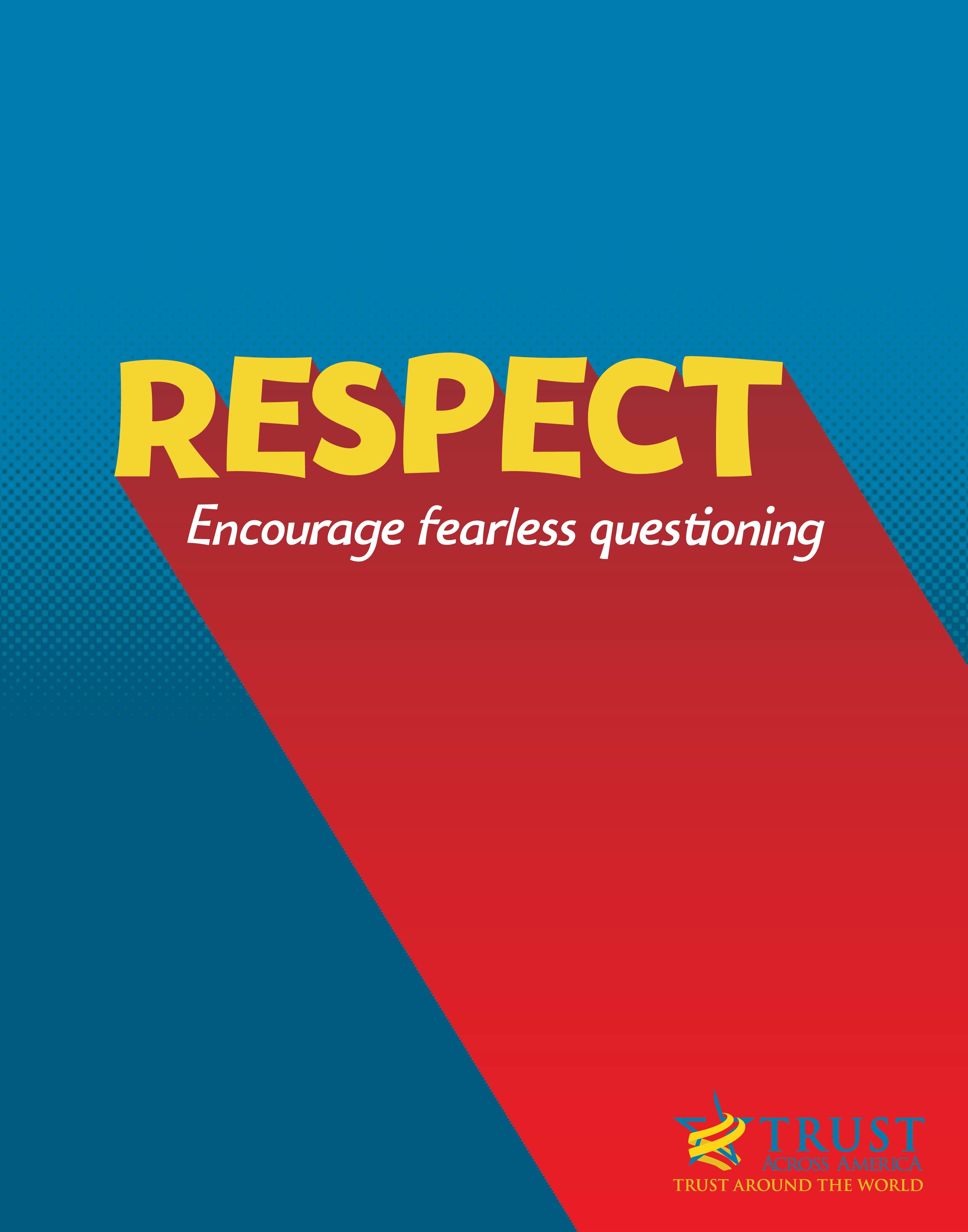
Do you respect your employees? Do they respect you?
How about your customers, suppliers and other stakeholders?
This world of ours… must avoid becoming a community of dreadful fear and hate, and be, instead, a proud confederation of mutual trust and respect. Dwight D. Eisenhower
To date, almost 30% of 600+ survey respondents say “Respect” is lacking in their workplace. Is it lacking in yours?
Respect is the ninth of *12 behaviors in our Tap Into Trust (TAP) framework having now been accessed over 150,000 times in 16 languages.
Trust Across America-Trust Around the World recently created The “Art” of Trust visual “cues” to start a discussion about workplace behaviors that build and weaken stakeholder trust. Together these cues form a “Wall” of Trust to enhance learning and retention.
In building team and stakeholder trust, we describe “Respect” as follows:
We respect each other – we encourage questioning and create a “zero fear” environment where innovation can thrive.
Our Trust Alliance members suggest the following discussion questions to elevate respect and build workplace trust.
-
- What are examples where respect has been demonstrated or damaged in (a) team meetings; (b) with customers; (c) with suppliers; (d) between leaders and their individual and collective team members; (e) between front line staff and executive leadership?
- What would it take to garner greater respect for our fellow work associates, our leaders, and our organization?
The “Art” of Trust is one of many resources designed for our Trust Action Project to help leaders, teams and organizations move from trust talk to ACTION in 2021 and beyond.
Would you like to build a Wall of Trust for your team? Take the first step.

Join our global Trust Alliance and participate in our programs.
Learn more about the Trust Action Project 2021 at this link.
*TAP INTO TRUST is an acronym. The 12 behaviors are equally weighted. The weakest behaviors break the trust chain.
Copyright 2021, Next Decade, Inc.
Barbara Brooks Kimmel, culture, integrity, leadership, organizational trust
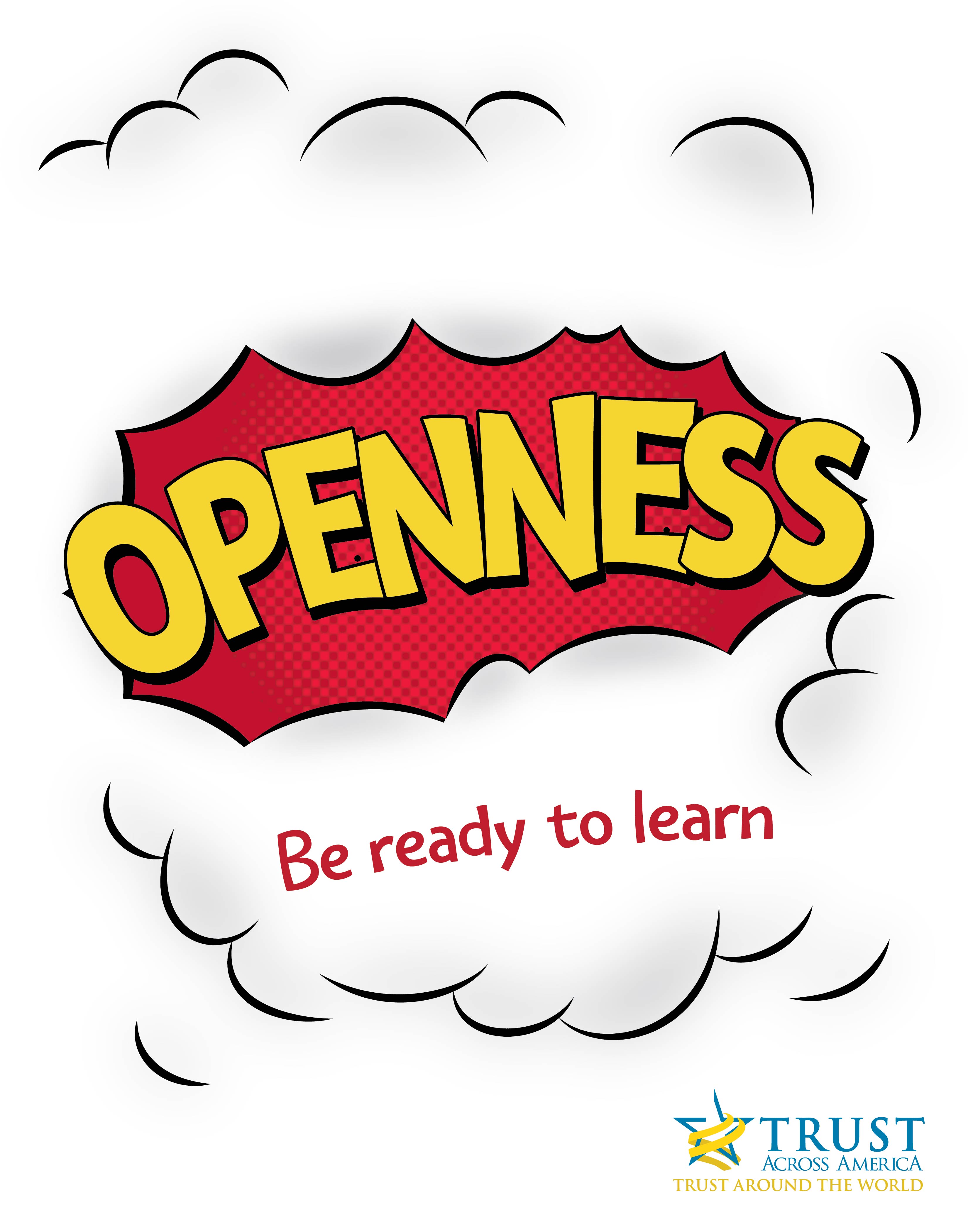
Are you open minded and ready to learn?
Or do you consider yourself the smartest person in the room?
To date, over 28% of 600+ survey respondents say “Openness” is lacking in their workplace.
Openness is the seventh of *12 behaviors in our Tap Into Trust (TAP) framework having now been accessed over 150,000 times in 16 languages.
Trust Across America-Trust Around the World created The “Art” of Trust visual “cues” to start a discussion about workplace behaviors that build and weaken stakeholder trust. Together these cues form a “Wall” of Trust to enhance learning and retention.
In building team and stakeholder trust, we describe “Openness” as follows:
We are open and ready to learn – we can be vulnerable and not have all the answers.
Our Trust Alliance members suggest the following discussion questions to elevate notice and build workplace trust.
- What are the existing or potential barriers that could prevent open, frank, and necessary conversations?
- Do we actively solicit feedback from superiors, peers, and direct reports to be sure we have the whole picture? If not, how can we improve our current feedback solicitation system?
The “Art” of Trust is one of many resources designed for our Trust Action Project to help leaders, teams and organizations move from trust talk to ACTION in 2021 and beyond.
Would you like to build a Wall of Trust for your team? Take the first step.

Join our global Trust Alliance and participate in our programs.
Learn more about the Trust Action Project 2021 at this link.
*TAP INTO TRUST is an acronym. The 12 behaviors are equally weighted. The weakest behaviors break the trust chain.
Copyright 2021, Next Decade, Inc.
Barbara Brooks Kimmel, barbara kimmel, culture, employee engagement, leadership, organizational trust, The "Art" of Trust, trust across america
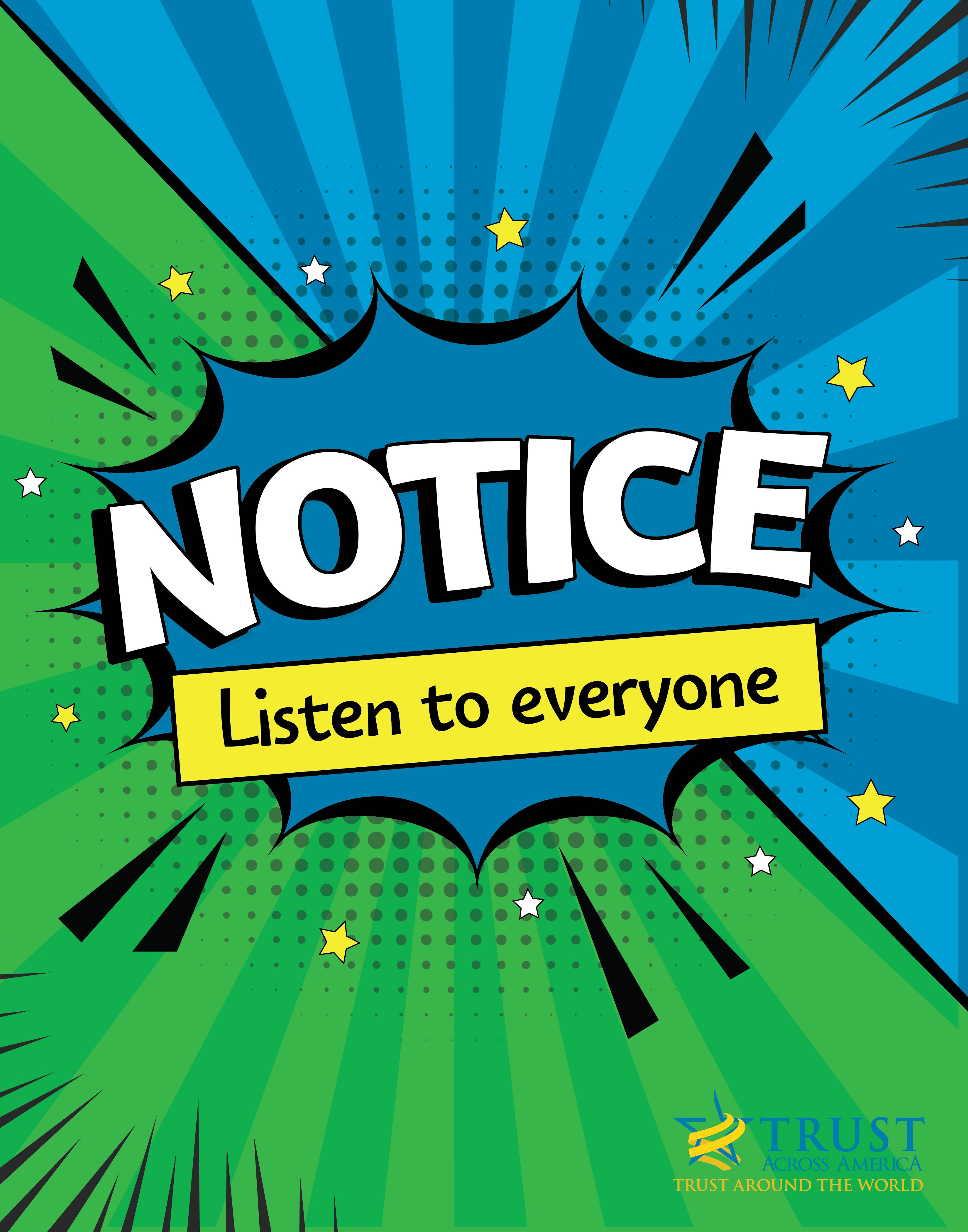
Do you listen to me?
Do you care what I have to say?
To date, over 32% of 600+ survey respondents say “Notice” is lacking in their workplace.
Notice is the fifth of *12 behaviors in our Tap Into Trust (TAP) framework having now been accessed over 150,000 times in 16 languages.
Trust Across America-Trust Around the World created The “Art” of Trust visual “cues” to start a discussion about workplace behaviors that build and weaken stakeholder trust. Together these cues form a “Wall” of Trust to enhance learning and retention.
In building team and stakeholder trust, we define “Notice” as follows:
We seek out and listen to diverse perspectives – every voice can matter.
Our Trust Alliance members suggest the following discussion questions to elevate notice and build workplace trust.
- What are concrete examples of ways to acknowledge and appropriately honor opposing opinions?
- How can we include all people in feedback rather than having some people feel forgotten?
The “Art” of Trust is one of many resources designed for our Trust Action Project to help leaders, teams and organizations move from trust talk to ACTION in 2021 and beyond.
Would you like to build a Wall of Trust for your team? Take the first step.

Join our global Trust Alliance and participate in our programs.
Learn more about the Trust Action Project 2021 at this link.
*TAP INTO TRUST is an acronym. The 12 behaviors are equally weighted. The weakest behaviors break the trust chain.
Copyright 2021, Next Decade, Inc.
Barbara Brooks Kimmel, culture, leadership, Trust Inc. 52 Weeks of Activities & Inspirations for Building Workplace Trust, values
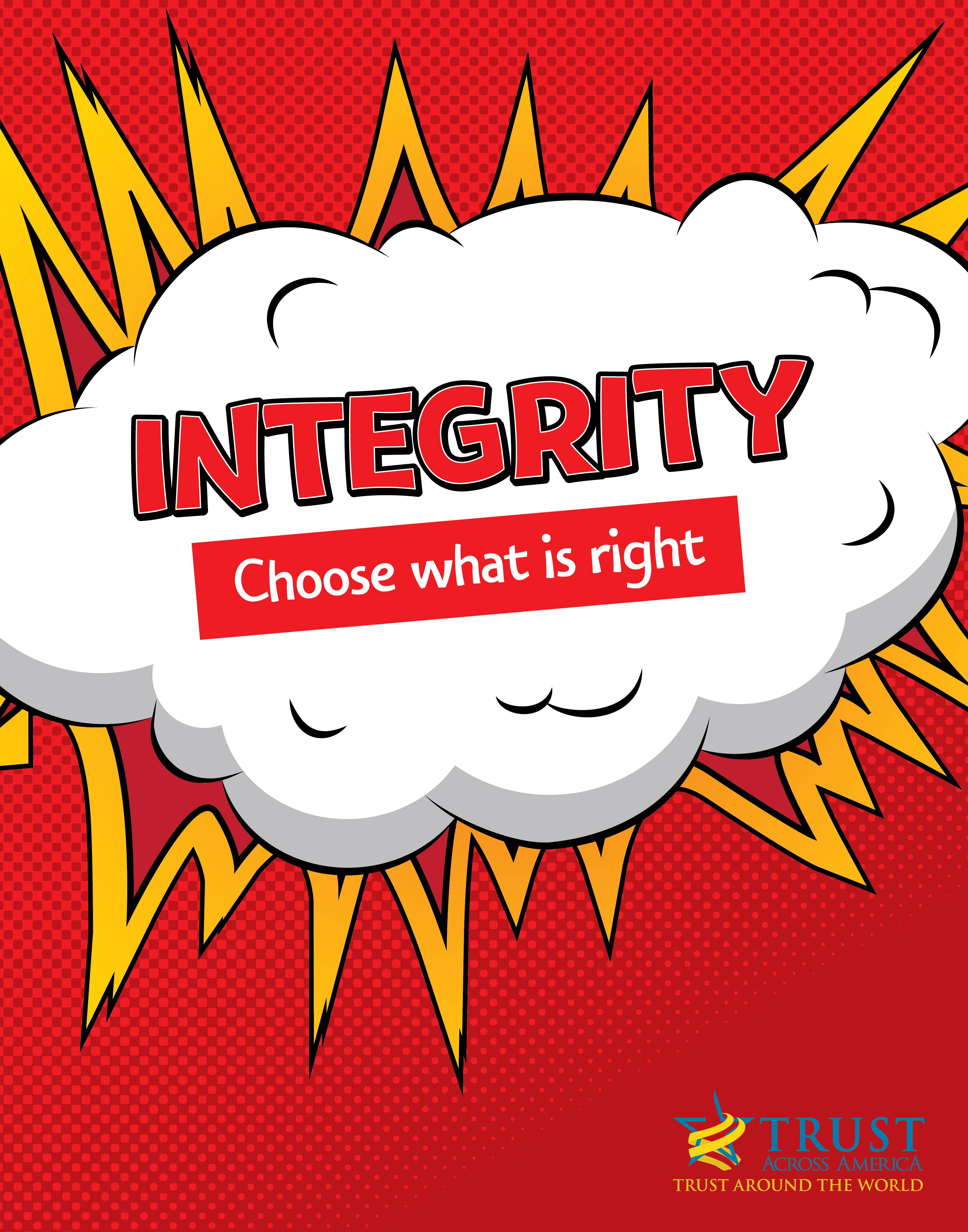
What is Integrity?
It is choosing to do what is right not just what’s regulated or legal.
Integrity is the fourth of *12 behaviors in our Tap Into Trust (TAP) framework having now been accessed over 150,000 times in 16 languages.
Trust Across America-Trust Around the World created The “Art” of Trust visual “cues” to start a discussion about workplace behaviors that build and weaken stakeholder trust. Together these cues form a “Wall” of Trust, telling a story to enhance learning and retention.
In the context of building team and stakeholder trust, we define “Integrity” as follows:
We do what we say – our everyday actions and talk are consistent.
To date, over 26% of our 600+ survey respondents identified “integrity” as lacking in their workplace.
Here are two discussion questions our Trust Alliance members suggest to elevate integrity and build workplace trust.
- Do we have and post our company’s values? If so, do we have a system in place whereby employees are invited annually to evaluate leadership’s adherence to its posted company values?
- What are some examples of our failure to act in the best interests of our customers, stakeholders and the public?
The “Art” of Trust is one of many resources designed for our Trust Action Project to help leaders, teams and organizations move from trust talk to ACTION in 2021 and beyond.
Would you like to build a Wall of Trust for your team? Take the first step.

Join our global Trust Alliance and participate in our programs.
Learn more about the Trust Action Project 2021 at this link.
*TAP INTO TRUST is an acronym. The 12 behaviors are equally weighted. The weakest behaviors break the trust chain.
Copyright 2021, Next Decade, Inc.
Barbara Brooks Kimmel, culture, integrity, leadership, organizational trust, trust, trust across america














Recent Comments